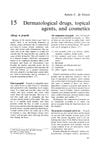21 citations
,
May 2014 in “Toxicological Sciences” Toluene diisocyanate exposure can cause immune sensitization by interacting with proteins in hair follicles and sebaceous glands.
17 citations
,
October 2012 in “European Journal of Pharmacology” Toluene lowers body temperature through different mechanisms depending on the concentration.
47 citations
,
June 2015 in “Contact Dermatitis” A standardized patch test for hair cosmetics is needed in Europe to prevent allergies, especially for hairdressers.
16 citations
,
October 2009 in “Xenobiotica” The tested hair dye ingredients do not form harmful oxidized metabolites in the liver.
 January 1993 in “Side effects of drugs annual”
January 1993 in “Side effects of drugs annual” Natural products like propolis are causing more skin allergies, and certain skin treatments and medications have various side effects and risks.
